SML1218
Pheophorbide-a
≥90% (HPLC)
Synonyme(s) :
pheophorbide a, (3S,4S,21R)-9-Ethenyl-14-ethyl-21-(methoxycarbonyl)-4,8,13,18-tetramethyl-20-oxo-3-phorbinepropanoic acid, Deacetyl-2-vinylbacteriopheophorbide, Pheophorbide a5
About This Item
Produits recommandés
Pureté
≥90% (HPLC)
Forme
powder
Conditions de stockage
protect from light
Couleur
blue, to dark brown to black
Solubilité
DMSO: 0.5 mg/mL, clear (warmed)
Température de stockage
−20°C
Chaîne SMILES
O=C([C@@H]1C(OC)=O)C(C(N/2)=C1C([C@@H](CCC(O)=O)[C@@H]/3C)=NC3=C/4)=C(C)C2=C\C5=N/C(C(C)=C5CC)=C\C6=C(C=C)C(C)=C4N6
InChI
1S/C35H36N4O5/c1-8-19-15(3)22-12-24-17(5)21(10-11-28(40)41)32(38-24)30-31(35(43)44-7)34(42)29-18(6)25(39-33(29)30)14-27-20(9-2)16(4)23(37-27)13-26(19)36-22/h8,12-14,17,21,31,36,39H,1,9-11H2,2-7H3,(H,40,41)/b22-12-,23-13-,24-12-,25-14-,26-13-,27-14-,32-30-/t17-,21-,31+/m0/s1
Clé InChI
NSFSLUUZQIAOOX-QEWKCGBTSA-N
Vous recherchez des produits similaires ? Visite Guide de comparaison des produits
Application
- for the photodynamic therapy (PDT) in oral cancer cell lines
- to test its effect on inducing oxidative stress and death in L. amazonensis
- to test its effect on the viability of HeLa cells
Actions biochimiques/physiologiques
Autres remarques
Code de la classe de stockage
11 - Combustible Solids
Classe de danger pour l'eau (WGK)
WGK 3
Point d'éclair (°F)
Not applicable
Point d'éclair (°C)
Not applicable
Certificats d'analyse (COA)
Recherchez un Certificats d'analyse (COA) en saisissant le numéro de lot du produit. Les numéros de lot figurent sur l'étiquette du produit après les mots "Lot" ou "Batch".
Déjà en possession de ce produit ?
Retrouvez la documentation relative aux produits que vous avez récemment achetés dans la Bibliothèque de documents.
Notre équipe de scientifiques dispose d'une expérience dans tous les secteurs de la recherche, notamment en sciences de la vie, science des matériaux, synthèse chimique, chromatographie, analyse et dans de nombreux autres domaines..
Contacter notre Service technique





